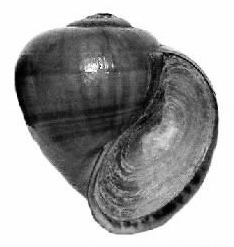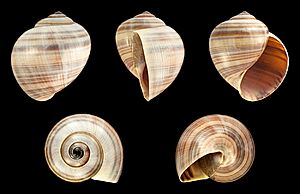Pila ampullacea facts for kids
Quick facts for kids Pila ampullacea |
|
|---|---|
 |
|
| The shell and operculum of Pila ampullacea | |
| Conservation status | |
| Scientific classification | |
| Genus: |
Pila
|
| Species: |
ampullacea
|
| Synonyms | |
|
|
Pila ampullacea is a type of freshwater snail. It's also known as an apple snail because of its round, apple-like shell. These snails live in water and are a kind of mollusk called a gastropod. They have a special lid called an operculum that can close their shell opening.
Where It Lives
This snail can be found in several countries in Southeast Asia. You can find Pila ampullacea in Thailand, Vietnam, and Indonesia.
What It Looks Like
Pila ampullacea has a round, spiral shell. The shell protects the soft body of the snail inside. Like all snails, it moves slowly on a muscular foot. It also has a special lid, the operculum, which helps it seal itself inside its shell. This protects the snail from drying out or from predators.
Used as Food
In some parts of Southeast Asia, Pila ampullacea is a traditional food.
- In Thailand, people have eaten Pila ampullacea for a long time. Another snail, Pila pesmei, was also traditionally eaten in rice fields. However, an invasive snail called the golden apple snail (Pomacea canaliculata) has become more common.
- In Indonesia, this snail is known as keong sawah or tutut. It is a popular traditional dish. People often boil or grill these snails. Sometimes, they are even made into satay, which are small pieces of food grilled on a stick.
See Also
 In Spanish: Pila ampullacea para niños
In Spanish: Pila ampullacea para niños



